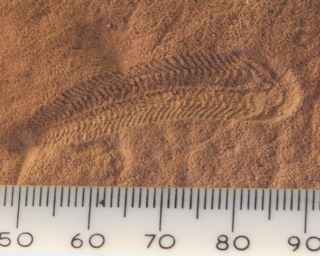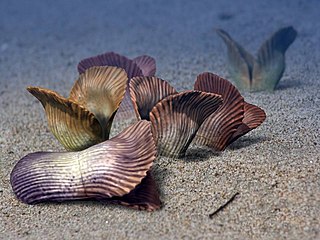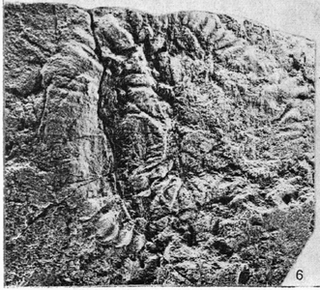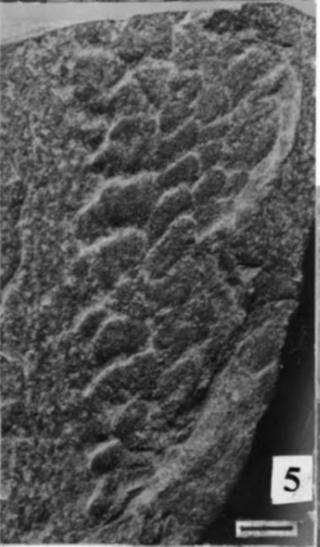
The Ediacaran period is a geological period of the Neoproterozoic era that spans 96 million years from the end of the Cryogenian period at 635 Mya, to the beginning of the Cambrian period at 538.8 Mya. It is the last period of the Proterozoic eon as well as the last of the so-called "Precambrian supereon", before the beginning of the subsequent Cambrian period marks the start of the Phanerozoic eon where recognizable fossil evidence of life becomes common.

Dickinsonia is a genus of extinct organism, most likely an animal, that lived during the late Ediacaran period in what is now Australia, China, Russia and Ukraine. It is one of the best known members of the Ediacaran biota. The individual Dickinsonia typically resembles a bilaterally symmetrical ribbed oval. Its affinities are presently unknown; its mode of growth has been considered consistent with a stem-group bilaterian affinity, though various other affinities have been proposed. The discovery of cholesterol molecules in fossils of Dickinsonia lends support to the idea that Dickinsonia was an animal, though these results have been questioned.

The Gunflint chert is a sequence of banded iron formation rocks that are exposed in the Gunflint Range of northern Minnesota and northwestern Ontario along the north shore of Lake Superior. The Gunflint Chert is of paleontological significance, as it contains evidence of microbial life from the Paleoproterozoic. The Gunflint Chert is composed of biogenic stromatolites. At the time of its discovery in the 1950s, it was the earliest form of life discovered and described in scientific literature, as well as the earliest evidence for photosynthesis. The black layers in the sequence contain microfossils that are 1.9 to 2.3 billion years in age. Stromatolite colonies of cyanobacteria that have converted to jasper are found in Ontario. The banded ironstone formation consists of alternating strata of iron oxide-rich layers interbedded with silica-rich zones. The iron oxides are typically hematite or magnetite with ilmenite, while the silicates are predominantly cryptocrystalline quartz as chert or jasper, along with some minor silicate minerals.

Tribrachidium heraldicum is a tri-radially symmetric fossil animal that lived in the late Ediacaran (Vendian) seas. In life, it was hemispherical in form. T. heraldicum is the best known member of the extinct group Trilobozoa.

Spriggina is a genus of early bilaterian animals whose relationship to living animals is unclear. Fossils of Spriggina are known from the late Ediacaran period in what is now South Australia. Spriggina floundersi is the official fossil emblem of South Australia; it has been found nowhere else.

The Ediacaranbiota is a taxonomic period classification that consists of all life forms that were present on Earth during the Ediacaran Period. These were enigmatic tubular and frond-shaped, mostly sessile, organisms. Trace fossils of these organisms have been found worldwide, and represent the earliest known complex multicellular organisms. The term "Ediacara biota" has received criticism from some scientists due to its alleged inconsistency, arbitrary exclusion of certain fossils, and inability to be precisely defined.

Ernietta is an extinct genus of Ediacaran organisms with an infaunal lifestyle. Fossil preservations and modeling indicate this organism was sessile and “sack”-shaped. It survived partly buried in substrate, with an upturned bell-shaped frill exposed above the sediment-water interface. Ernietta have been recovered from present-day Namibia, and are a part of the Ediacaran biota, a late Proterozoic radiation of multicellular organisms. They are among the earliest complex multicellular organisms and are known from the late Ediacaran. Ernietta plateauensis remains the sole species of the genus.

Fractofusus misrai is an Ediacaran fossil discovered in 1967 by S.B. Misra at Mistaken Point, Newfoundland and Labrador, Canada, which has since become the Mistaken Point Ecological Reserve. It was named after Professor Misra in 2007. It represents a frondose rangeomorph.
Vaveliksia is an extinct genus of Ediacaran Sponge-like organism with a long, tubular-shaped body and a attachment disk similar to that of Petalonamids. The Vaveliksia genus contained two species, Vaveliksia velikanovi as well as Vaveliksia vana. The two species vary in appearance to one another, with V. velikanovi having a more tubular-shaped, sack-like morphology with a crown of wrinkles on top of one of its ends as well as possessing a much more disk-like holdfast with V. vana having an appearance more similar to that of a Poriferan, with V. vana having a much more dome-shaped holdfast and a capsule-like body with no crown of wrinkles unlike V. velikanovi.

The Nama Group is a 125,000 square kilometres (48,000 sq mi) megaregional Vendian to Cambrian group of stratigraphic sequences deposited in the Nama foreland basin in central and southern Namibia. The Nama Basin is a peripheral foreland basin, and the Nama Group was deposited in two early basins, the Zaris and Witputs, to the north, while the South African Vanrhynsdorp Group was deposited in the southern third. The Nama Group is made of fluvial and shallow-water marine sediments, both siliciclastic and carbonate. La Tinta Group in Argentina is considered equivalent to Nama Group.

Arumberia is an enigmatic fossil from the Ediacaran period originally described from the Arumbera Sandstone, Northern Territory, Australia but also found in the Urals, East Siberia, England and Wales, Northern France, the Avalon Peninsula and India. Several morphologically distinct species are recognized.

The Mistaken Point Formation is a geologic formation in Newfoundland and Labrador. It is recognized as a Lagerstätte preserving fossils dating back to the Ediacaran period. It contains a stratum dated to 565 ± 3 million years ago.

Veprina is a rare Ediacaran coelenterate cnidarian found on the Zimny coast of the White Sea, Russia and was first described by Mikhail Fedonkin in 1980.
Palaeoplatoda is a genus from the Ediacaran biota. It is a soft-bodied organism with a segmented body that resembles Dickinsonia, another Ediacaran organism.
Atakia is a genus of animals that were members of the Ediacaran fauna, which existed from 635 to 541 million years ago. Discovered in Ukraine in 1979 by Palij, the genus Atakia are soft-bodied Metazoan cast in Vendian sediments found on the Eastern European Platform formations. Oftentimes the genus Atakia is used as a comparison to other genera, because very little information is known about this genus. There is a discontinuity in identification because the genus Fustiglyphus Vialov is debated to be the same as Atakia but found in different regions.

Zolotytsia is an extinct genus of fossil animals from the late Ediacaran period (Vendian) which contains only one known species, Z. biserialis. Specimens of this species have been found in Russia, Ukraine and India.

A "Palaeopascichnid" describes a multitude of elongate fossils made up of multiple sausage-shaped chambers. They appear only in Ediacaran sediments. Fossils of Palaeopascichnids consist of an occasionally branching series of globular or elongate chambers. These fossils started appearing in the Vendian about 580 million years ago. Fossils of Palaeopascichnids are found in East European platform, Siberia, South China (Lantian), Australia, India (Tethys), Avalonia
Tirasiana is a genus of disc-shaped animals from the Ediacaran period that contains three species: T. concentralis, T. coniformis and T. disciformis, all which are distinguished by the complexity of their stepped structure.

Pseudorhizostomites howchini is an enigmatic member of the Ediacaran Biota which was originally thought to have been a jellyfish of some kind. P. howchini is now though to either have been a pseudofossil, a gas escape structure or perhaps the result of a rangeomorph holdfast being pulled by currents or, if any of these possibilities are not true, some other force from the sediments which enclosed the fossil.














